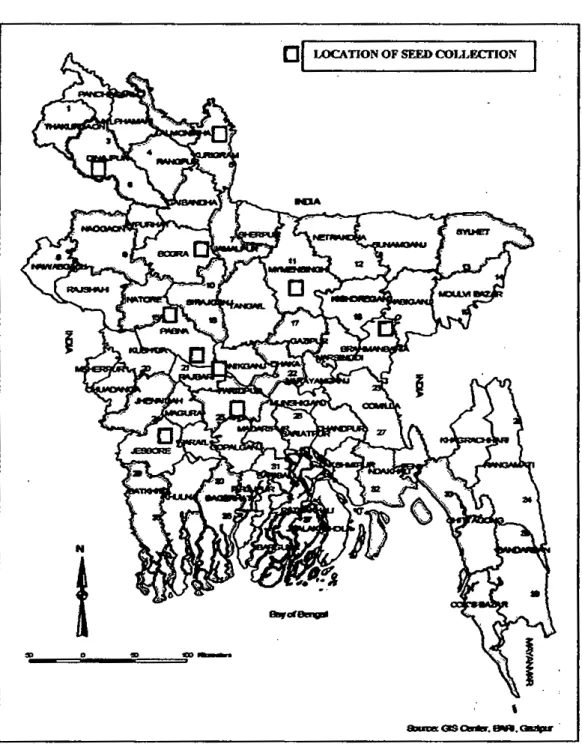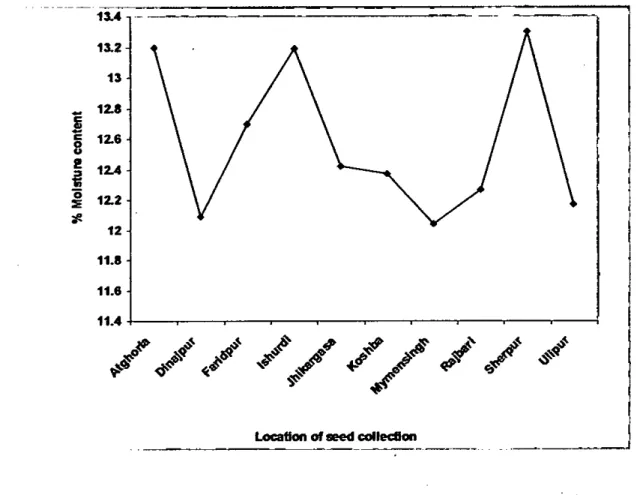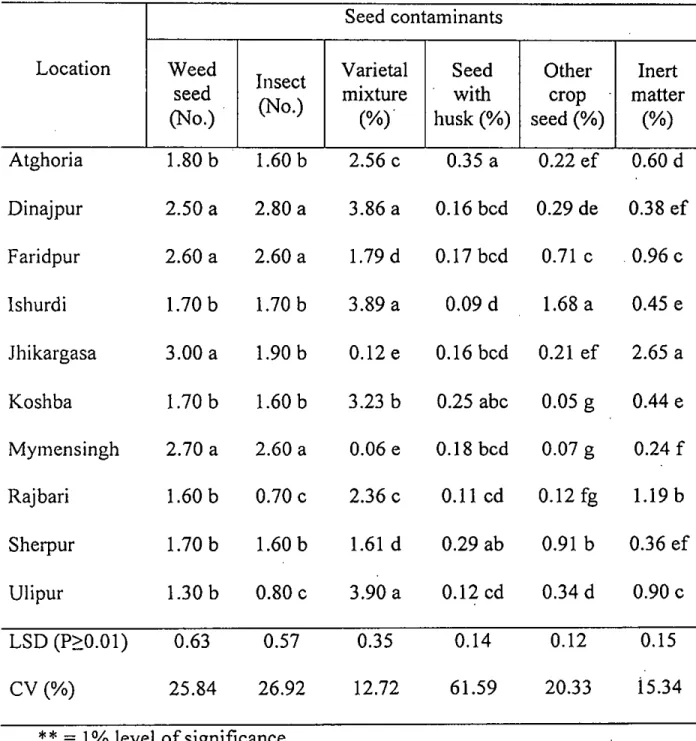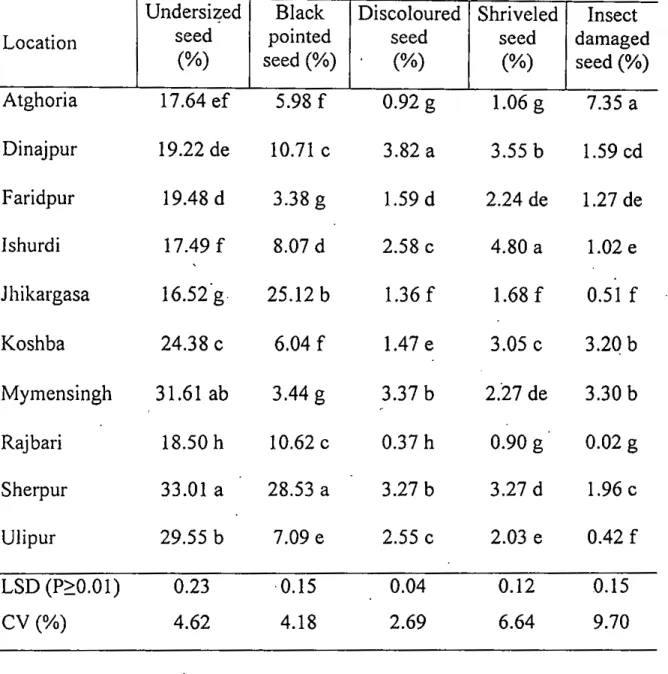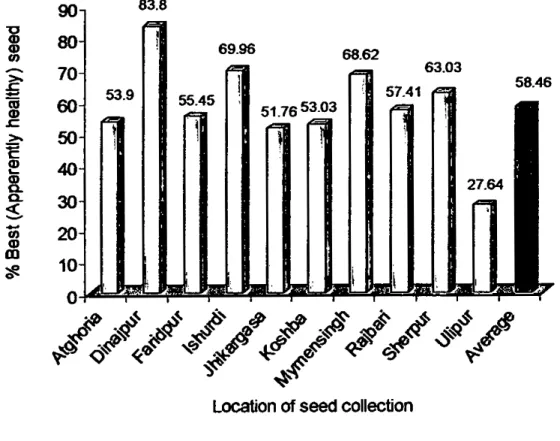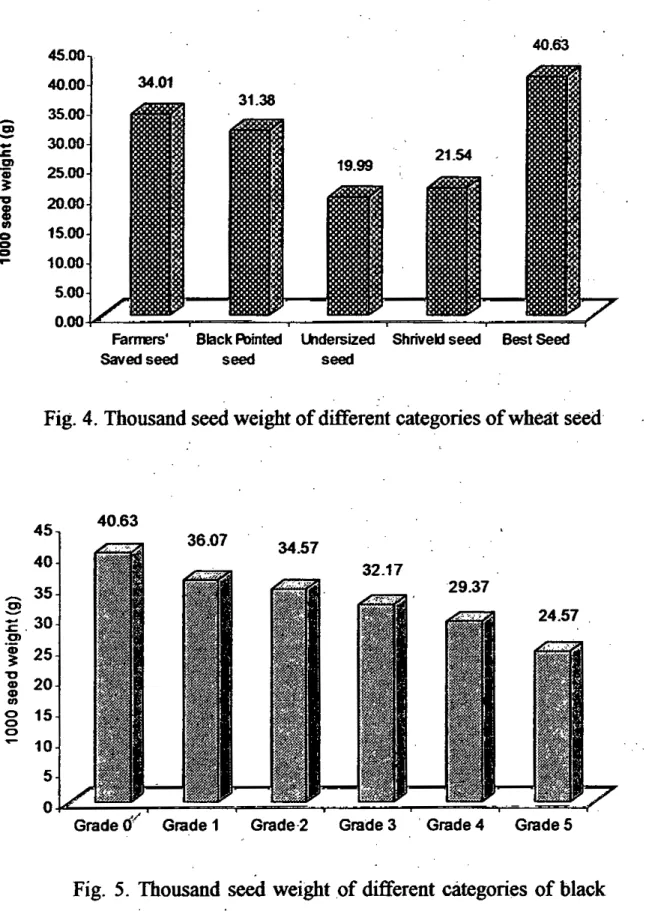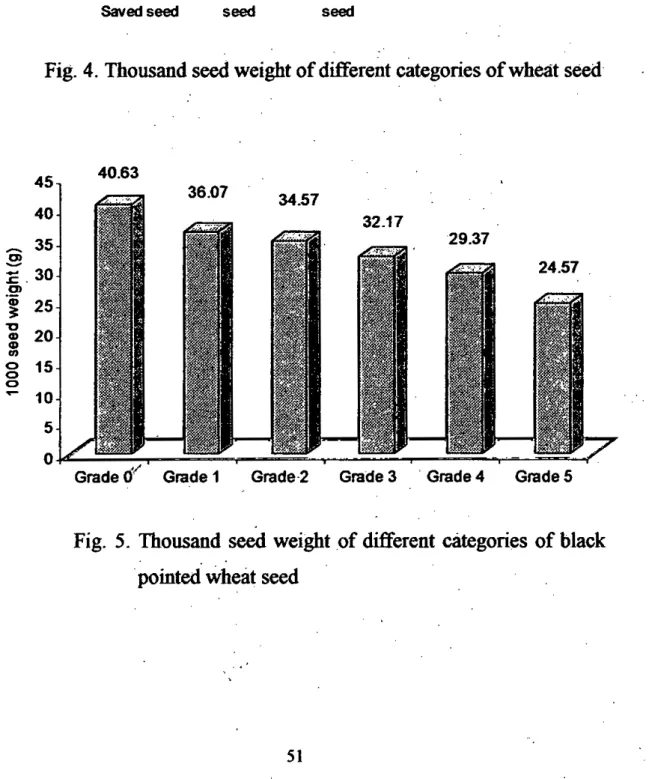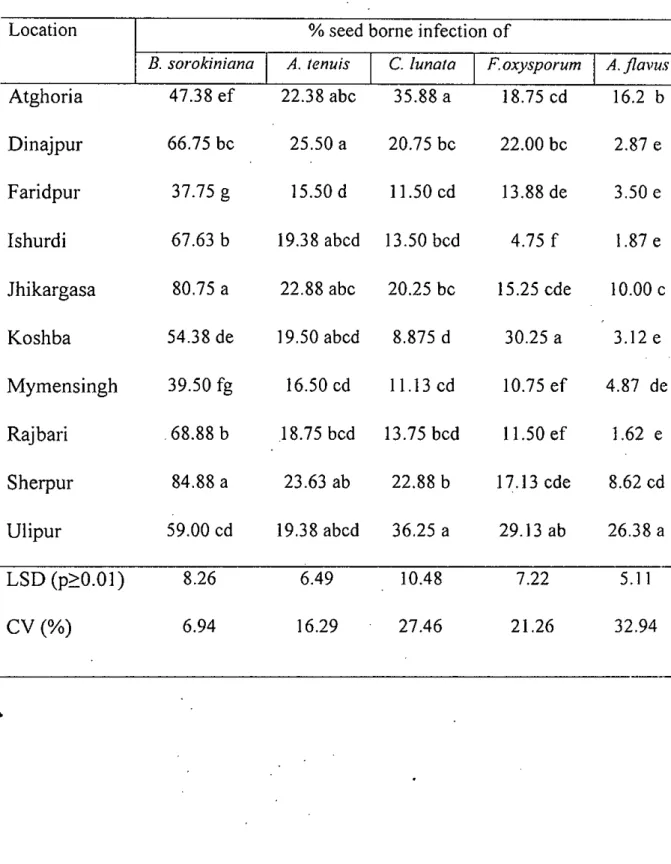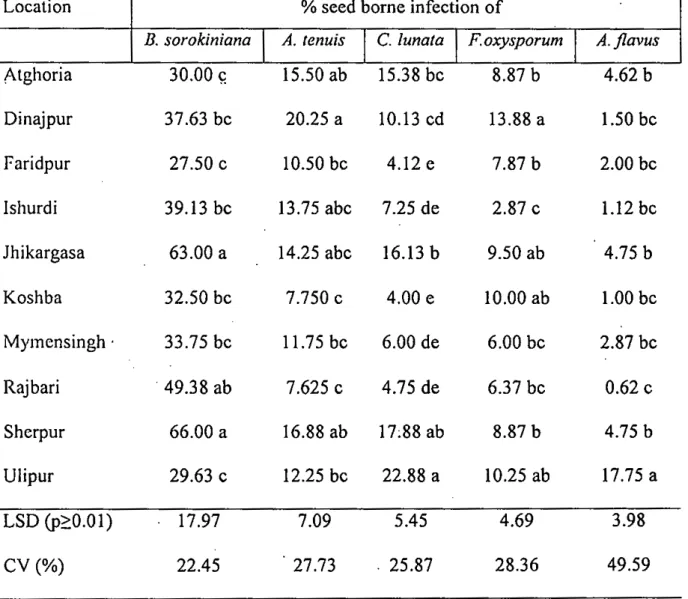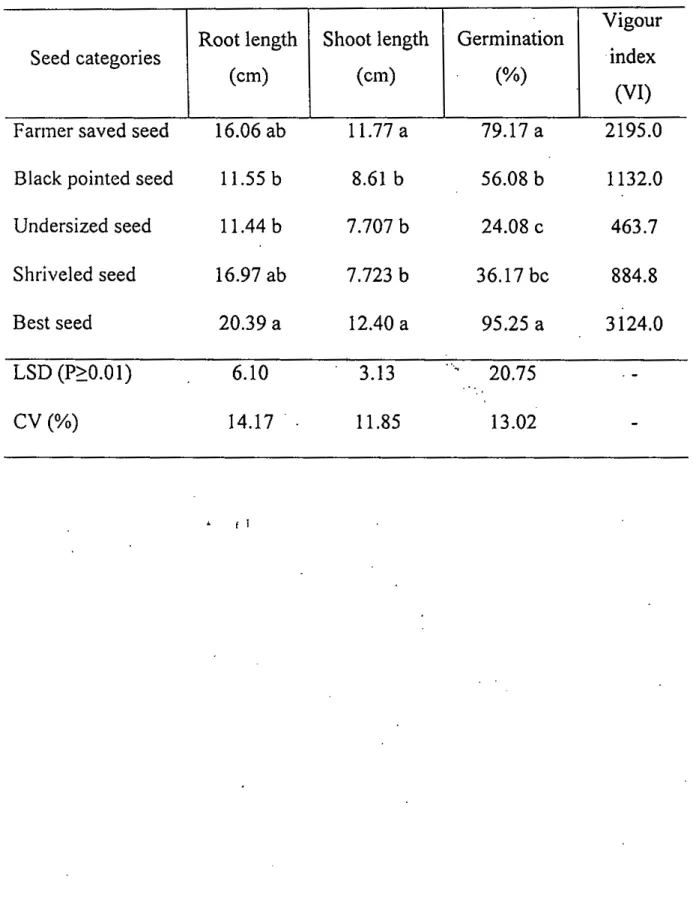[1-13/14J
STUDY ON TIlE QUALITY AND HEALTH STATUS OF FARMER SAVED WHEAT SEED IN BANGLADESH
NAZMOONNAHERTONU
., Registration No.15483J01517
. ...,. . .
\ \\~"
~~~\"
37343~~\\"'~,
~~D.EPARTMENT
OF PLANT PATHOWGY
SHER-E-BANGLA AGRICULTURAL UNIVERSITY DHAKA-1207
2006
STUDY ON THE QUALITY AND HEALTH STATUS OF FARMER SAVED WHEAT SEED IN BANGLADESH
Registration No. 25483/01517
A Thesis
Submitted to the Faculty of Agriculture, Sher-e-Bangla Agricultural University, Dhaka
<.. In partial fulfillment of the requirements For the degree of
~ .
MASTER OF SCIENCE
IN
'PLANT PATaOLOGY
SEMESTER: JANUARY -JUNE, 2006
Approved by:
(Dr.
Md. Rafiqul Islam) Associate Professor Department of Plant Pathology
Sher-e-Bangla Agricultural University Supervisor
(Dr.
Md. Abu Taber Mia) Principal Scientific officer Bangladesh Rice Research Institute
Joydebpur, Gazipur-170 1
Co-Supervisor
(Dr.
Md. Rafiqul Islam) Chairman
Examination Committee
CE'RTInCA IT
This is to certify that thesis entitled, "STUDY ON THE QUALITY.
AND HEALTH STATUS' OF FARMER SAVED WHEAT SEED'IN . BANGLADESH" submitted to the Faculty of Agriculture, Sher-e-Bangla
Agricultural University, Dhaka, in partial fulfillment of the requirements for the degree of MASTER OFSCIENCE in PLANT PAT~OLOGY, embodies the result of a piece of bonafide research work carried out by Nazmoon Naher Tonu, Roll No. 01517, Registration .No. 25483/01517, under
my
supervision and :guidance. No part of the thesis has been submitted for any other degree or diploma.
\
I further certify that any such help or sources of information, as has been availed of during the course of this investigation has been duly acknowledged by her -.
Dated:
31.08.2006
Dhaka, Bangladesh(Dr. Md. Rafiqul Islam) Associate Professor
Department of Plant Pathology Sher-e-Bangla Agricultural University
Supervisor·
.,'
r
r
Ded6c~~ed to
ffi'lily
~-~-==-~~~
~eJm7a~~r~~Js
•
/
ACKNOWLEDGEMENT
.....
All praises to Almighty "ALLAH"Who enabled me to pursue my higher study and to complete the thesis work as well as to submit the thesis for the degree 'of Master of Science (M. S.) in Plant Pathology at Sher-e-Bangla Agricultural University, Dhaka.
The author deems it a proud .privilege to express the deepest sens~ of gratitude, sincere appreciation and profound regard to her Supervisor, Dr. !
Md Rafiqul Islam, Associate Professor and Chairman, Department of Plant Pathology, Sher-e-Bangla Agricultural· University, Dhaka, for his valuable suggestions and constant encouragement through the entire period of research
,
work. The author is deeply indebted to him.
The author expresses his deepest sense of gratitude, immense indebtedness and grateful appreciation to his Co-supervisor, Dr. Abu Taher Mia, Principal Scientific Officer, Division of Plant Pathology, Bangladesh Rice Research Institute, J:oydebpur, Gazipur for his precious advice, instruction, irysp,iration and valu~ble suggestions for improvement of this thesis and his cordial help to complete the research work successfully.
The author would like to extend heartfelt gratitude to her respected father Prof. Dr. Golam Ali Fakir, Adjunct, Professor, Department of Plant Pathology, Sher-e-Bangla Agricultural University, Dhaka and former Vice- chancellor, Khulna University for his keen interest, scholastic guidance, constructive criticisms,continuous inspiration and financial support duri!1g the entire period of research and preparation of the manuscript.
The author is grateful to Dr. M. Harunor Rashid, Sernior Scientific Officer, PRC, BARI, Ishurdi for his sincere help for statistical anylysis,
preparation of the manuscript and collection of seed samples used for the study ..
Thanks are also extended to Dr. M. Abu Bakr, CSO and Head Division of Plant Pathology, BARI, -Gazipur and Mr. Mobarak Hossain; Assistant Professor,
Department of Plant Pathology, Hajee Danesh Science and Technology University, Dinajpur for their help in obtainning the wheat seed samples for the present study.
The author is indebted to her respected teachers-Professor Nasim A'k~tar, Assistant Prbfessors, Mr. M. Salahuddin Mahmood Chowdhury, Dr. F.M.
Aminuzzaman and Nazneen Sultana, and Khadija Akhter, Lecturer, Department of Plant Pathology, Sher-e-Bangla Agricultural University, Dhaka for their inspiration and co- operation throughout the entire period of the research work.
The author expresses her thanks to Mrs. Kishwar Sultana, PSO.
Bangladesh Jute Research Institute, Dhaka for her help in conducting some of the research experiments.
Special thanks are due to Nasreen, Aminul, Sohel and Moshiur, for their friendly co-operation, inspiration and help during the study period and' ( preparation of the manuscript. Thanks are extended to the Laboratory staffs, Department of Plant Pathology, Sher-e-Bangla Agricultural University, Dhaka for their help and co-operation during the research work.
The author expresses her heartfelt gratefulness to her respected mother, Mrs. Rasheda Ali; sister, Dona; brother, Nafee; relatives and well wishers without whose blessings, sacrifices and constant inspiration the present research work would have not been possible.
Author
STUDY ON THE QUALITY AND HEALTH STATUS OF FARMER SAVED WHEAT SEED IN BANGLADESH
NAZMOON NAHER TONU ABSTRACT
Quality and health status of farmer saved wheat seed of cv Kanchan grown in 2004-05 was determined by seed health and quality analysis.
One hundred seed samples collected from 100 farmers representing ten upazilas under nine major wheat growing districts of Bangladesh were included for the study. Seed health and quality analysis revealed that moisture content of farmer saved seed ranged between 12.04-]3.30%. Six types seed contaminants recorded in farmers' seed were - weed seeds, insects, varietal mixture, seed with husk, other crop seed and inert matter.
Farmer saved seed also contained five types of abnormal seeds viz black pointed seed, discoloured seed, undersized seed, shriveled seed and insect damaged seed. On an average, 58.48% 'clean' or 'best' seed was recovered from farmer saved wheat seed by removing the seed contaminants and abnormal seeds through manual seed cleaning. Clean seed had the highest weight, while the undersized and black point Grade
5
seeds were lighter than all other categories of wheat seed. Occurrence of seed contaminants, abnormal seeds and the sorted out clean seed from the farmer saved seed varied depending on the seed sources. Of the 13 fungi encountered in farmers' seeds, five target pathogenic fungi identified, in order of prevalence, were - Bipolaris sorokiniana, Alternaria tenuis, Curvularia lunata, Fusarium oxysporum and Aspergillus flavus. Incidence of these target fungi in both unclean and clean seeds varied significantly with respect to location of seed collection. All the five target fungal pathogens were more prevalent in farmers saved seed compared to clean seed. 'Clean' or 'best' seed significantly gave higher counts of normal seedlings and lesser percentage of abnormal seedlings and dead seeds over unclean farmers' seed and abnormal seeds like black pointed, undersized, discoloured and shriveled seeds. Similarly clean seed resulted higher germination and seedling vigour index over unclean and abnormal seeds.LIST OF CONTENTS
CHAPTER TITLE PAGE
ACKNOWLEDGEMENT i
ABSTRACT iii
LIST OF CONTENTS iv
LIST OF TABLES VI
LIST OF FIGURES vii
LIST OF PLATES viii
LIST OF APPENDIX
x
1. INTRODUCTION 1
2.
REVIEW OF LITERATURE6
3. MATERIALS AND METHODS' 22
3.1
Experimental Sites22
3.2
Experimental Period22
3.3
Locations of Seed Collection22
3.4
Cultivar Used24
3.5
Collection of Seed Samples24
3.6
Preservation of Seed Samples24
3.7
Seed Quality and Health Analysis25
3.7.1
Determination Of Moisture Content25
3.7.2
Sorting Of 'Best' Or Apparently Healthy Seeds25
3.7.3
Grading Of Black Pointed Seeds27
3.7.4
Determination Of Seed Weight29
3.7.5
Detection of seed - borne fungi29
"t...~.. ,3
CHAPTER TITLE PAGE
3.7.6 Determination of Germination 30
3.7.7 Determination of Seedling Vigour 32
3.8 Statistical Analysis 32
4. RESULTS 33
4.1 Moisture Content 33
4.2 Seed Contaminants 34
4.3 Abnormal Seeds . 41
4.4 'Clean' or 'Best' (Apparently Healthy) Seed 47
4.5 1000 Seed Weight 50
4.6 Prevalence of Fungi 52
4.7 Prevalence of Target Pathogenic Fungi 52
4.8. Germination 64
4.9.1 Seedling vigour observed in different 69 categories of wheat seeds
4.9.2 Seedling vigour observed in different grades 73 of black pointed seeds
5.
DISCUSSION . 776.· 'SUMMARY AND CONCLUSION 85
7. REFERENCES 90
8.-
APPENDIX 106LIST OF TABLES
TABLE NO
TITLE PAGE
1
2 3
4
5 6
Seed contaminants recorded in farmers' saved wheat 40 seed collected from - ten different locations - of
Bangladesh
Abnormal seeds recorded in farmers' saved wheat 46 seed collected from different locations qf Bangladesh
Prevalence of five target pathogenic fungi in unclean 62 farmers' saved wheat seed collected from 10 different
locations of Bangladesh.
Prevalence of five target pathogenic fungi in clean 63 farmers' saved wheat seed collected from 10 different
locations of Bangladesh
Seedling vigour "recorded in different categories of 70 wheat-seed
Seedling vigour recorded in different grades of black \ 74 pointed seeds
LIST OF FIGURES
/
FIGURE NO.
TITLE PAGE
1. 23
2.
3.
4.
5.
6.
7.
8.
9.
Map of Bangladesh showing the locations of seed collection
Moisture content of farmer saved wheat seed collected from ten different locations of Bangladesh
'Best' or apparently healthy wheat seed recovered from farmers saved wheat seed collected from ten different locations of Bangladesh
Thousand seed weight of different categories of wheat seed
Thousand seed weight of different categories of black pointed wheat seed
A.
verage percent seed-borne infection of the five target pathogenic fungi encountered in unclean and clean seeds (average of 10 locations)Percentage of normal seedling In clean and unclean wheat· seeds collected from 10 different locations of Bangladesh
Percentage of .abnormal seedling in clean and unclean wheat seeds collected from 10 different locations of Bangladesh
Percentage of dead seeds in .clean and unclean wheat seeds collected from 10 different locations of Bangladesh
33
49
51 51
67
67
68
,
• I
LIST OF PLATES
~.c·Or: ~~
FIGURE NO.
TITLE PAGE
1.
2.
3.
" 4.
5.
6 7
8
9 10 11 12
13
14
Black pointed wheat seeds of different grades (0-5) 28 Weed seed sorted out from farmers' saved wheat ' 35 seeds
Insects sorted out from farmer saved wheat seeds '36 A. Weevil, B. Rice moth, C. Red flour beetle
(. '37
Varietal mixture sorted out from farmirs' saved wheat seed. ..
"
Seed with husk sorted out from farmers' saved wheat seed
37
. Other crop seeds sorted out from farmers' saved
wheat seed .
38
Inert matter sorted out from farmers' saved wheat seed.
38
. ~
Undersized geed sorted out froth farmers' saved wheatseed
42
• ....
J
Black pointed seed sorted out from.farmers' saved
wheat seed •
42 Discoloured seed sorted out from, farmers' saved'
.
wheat seed.. \,;'-. -
43 '
•
Shriveled seed sorted out from farmers' saved wheat seedInsect damaged seed sorted out from farmers' saved wheat seed
'Clean' or 'Best' seed sorted out from farmers' , saved wheat seed
43
4~ .
48
A. Growth of Bipolaris sorokiniana on wheat seed incubated in blotter (X 45)
B. Conidia of Bipolaris sorokiniana (X 100)
, -54
",
.
FIGURE
NO.TITLE PAGE
15 55
16
17
18
19
20
21
22
23
A. Growth ofAlternaria tenuis on incubated wheat seed in blotter (X 45)
B. Conidia of Alternaria tenuis (X 100)
A. Growth of Curvularia lunata on incubated wheat seed in blotter
ex
45)B. Conidia of Curvularia lunata (X 100)
A. Gtowth of Fusarium oxysporum on incubated wheat seed in blotter (X 40)
B. Conidia of Fusarium oxysporum
ex
100). A. Growth of Aspergillus flavus on incubated wheat seed in blotter (X 80)
B. Conidia of Aspergillus flavus (X 400) (a) Normal seedling
(b) Abnormal seedling and (c). Dead seed
Germination of different categories of wheat seeds A. Farmer saved seed B. Black pointed seed Germination of different categories of wheat seeds A. Undersized seed B. Shriveled seed C. Best seed Germination of Black pointed seeds
A. Grade 0 B. Grade 1 C. Grade 2 Germination of Black pointed seeds
A. Grade 3 B. Grade 4 C. Grade 5
ix
56
57
66
71 72
75 76
.' ;.
. ...
APPENDIX
APPENDIX TITLE PAGE
NO
1. List ..of farmers along with their address from 106 where wheat seeds (cv. Kanchan) were collected
2. Fungi detected in wheat seeds (cv. Kanchan) 109 collected from ten different locations : of
Bangladesh
.''';'~:~.
~!l~jgr 1
Introduction
.'
1. INTRODUCTION·
Wheat (Triticum aestivum L.) is the second most important staple food crop next to rice in Bangladesh. At present, 12.53 million metric tons of wheat produced in 6.25 million ha of 1and in the country (BBS, 2004).
The average yield of wheat is only 1992 kg/ha. in Bangladesh, which is too low as compared to the developing countries of the world like Egypt, Zambia, U.K. Denmark, Ireland and Netherlands producing 6150, 6452, 7778,7832,7862,9110 kg/ha., respectively (FAO, 2003). Thus the yield' of wheat in the country is relatively low.
Among the various factors responsible for low yield of the crop, diseases and low seed quality playa vital role. Wheat suffers from as many as 120 different diseases, out of which 42 are seed-borne (Richardson, 1990;
Weise, 1991; Mathur and Cunfer, 1993). Coincidentally, seed-borne diseases of wheat are more devastating in nature and have worldwide occurrence. Of all the seed borne diseases, leaf
blight
tBipoiaris sorokinianai, yellow spot (Bipolaris tritici repentisi, loose smut (Ustilagotrifid), bunt iTilletia spp.), glume blotch (Stagvl1uspvra nodorumi, head blight (Fusarium spp.), black point iBipolaris sorokiniana, Curvularia lunata, Cladosporium cladosporoides and Fusarium. sp.) and germination.
failure or seed rot (Fusarium spp, Bipolaris spp and Aspergillus spp.) are of considerable importance. A good number of these diseases outbreak in epidemic form in many wheat growing countries and cause heavy production losses (Bazlur Rashid et al. 1983; Weise, 1991; Mathur and Cunfer, 1993; Bazlur Rashid and Fakir, 1998; Fakir, 1998; Bazlur Rashid and Fakir, 2000).
In Bangladesh, 16 different diseases are known to occur on wheat. Of these, 12 are seed borne (Fakir et al., 1990; Fakir, 2001). Among the seed borne diseases, leaf blight caused by Bipolaris sorokiniana is the most devastating disease. The disease has been found to break out in epidemic form when there are rains during grain formation and maturation. Leaf blight of wheat is known to cause heavy losses almost every year in the country. Besides leaf blight, other seed borne diseases namely black point (Bipolaris sorokiniana, Curvularia lunata, Alternaria tenuis, Fusarium sp.), yellow spot (Bipolaris tritici repentis) and loose smut (Ustilago triticiy also attack the crop and causes considerable losses to wheat production.
Seed is the most important input for crop production and quality healthy seed is the crying need of the day. Good or quality healthy seed means good crop. This truth is also applicable for wheat seed. In Bangladesh, of
the total wheat seed requirement, only 10% seed produced by BADe, NGOs and seed companies are of good quality to some extent. These seeds are being tested for quality and certified or truthfully labeled.
Again, the quality of this seed is judged only by purity and germination.
No attention is paid to seed health. The rest 90% wheat seeds are produced by the fanners with little or without care. Traditionally, our farmers grow wheat for consumption purpose. From this produce, they save a portion and keep them as seed. These farmer-saved seeds are never tested for quality. Obviously, these seeds are of poor quality and often infected by pathogens.
Infected wheat seeds fail to germinate or the young seedlings emerging from the infected seeds die resulting germination failure, post emergence damping off and seedling blight. Growing wheat plants in the field from the infected seeds, escaping early infection, may often be infected at the later stages of its growth by the primary seed-borne inoculum grown and multiplied out of the infected dead seeds and seedlings. Later on, these inocula may be transmitted to the healthy growing plants of the same or neighboring plants or even neighboring field resulting disease outbreak, often in epidemic form. Seed-borne pathogens, causing diseases on the growing wheat plants in the field quite often attack spike or spike-lets and subsequently infect the seeds.
The pathogens present in the infected seeds will remain alive in dormant condition as long as the seed remains viable (Neergaard, 1977). As these pathogens are very small and microscopic in nature their presence in or on the seed cannot be seen from outside with naked eyes. However, sometimes infected wheat seeds may be recognized by observing various kinds of lesions/spots, discoloration, deformation and other abnormalities.
Propagules of different pathogens present in dusts, soil particles or infected crop debris (inert matter) may also be mixed with seeds in a given seed lot during the process of harvesting, winnowing and storage.
Presence of insects, weed seeds, seeds of other wheat varieties as well as other crop seeds are not also hygienic for the seed lot. Thus, wheat seeds can be infected by seed-borne pathogens or it can carry pathogens as contamination or concomitant contamination. There are also evidences that undersized wheat seeds are poor as regard to seed health quality
\ \
(Huguelet and Kiesling, 1973; Adlakha and Joshi, 1974; Ram and Joshi, 1979). Such infected seeds and seed lots having contaminants and abnormal seeds signify the poor health and quality of wheat seeds.
In Bangladesh, considerable amount of works have been done on seed- borne fungi, seed health, seed-borne diseases of wheat and their control
,
(Fakir et.al., 1977; Bazlur Rashid, et al., 1992; Bazlur\Rashid, 1996;
,
'. . k.) .: \.
Bazlur Rashid and Fakir, ] 998; Fakir, 1998; Hossain et al., 1998; Bazlur
"
\ .
Rashid and Fakir, 2000; Khokdn et al.,2005). But very limited
.' \
information is available on the use of quality healthy wheat seeds in the country.
\
From the foregoing deliberations, it appeal's that seed-borne diseases are responsible for low yield and production of poor quality wheat seeds in Bangladesh. But the health status of wheat seeds produced by the farmers in the country is not preciously known. But successful wheat cultivation largely depends on the use of quality healthy seeds.
In view of the above facts, the present investigation has been undertaken to determine the quality and health status of wheat seeds produced by the farmers in Bangladesh. The information generated will be useful for further activities to improve fanners', seed quality, if necessary, for' sustaining crop yield.
,,
.&Jt~~t_2
Review of literature
2. REVIEW OF LITERATURE
Health of Seed can be affected through direct infection by pathogens without showing any visible symptoms. Often infected seeds may be recognized by observing spots, lesions or different kinds of symptoms produced by the invading pathogens. Propagules of different pathogens present in dusts/soi Is, crop residues, weed or other crop seeds as contamination or concomitant contamination in a given seed lot also indicate unhealthiness or ill seed health. Thus, like many crop seeds, wheat seeds can be infected by pathogens or a given seed lot of the crop can carry propagules of pathogens as contamination or concomitant contamination. There are evidences that cleaning or removal of infected/abnormal seeds and seed contaminants by manual physical seed sorting can improve the seed health status. An attempt has been made here to collate the relevant literature on the health of wheat seeds affected by pathogens or propagules of pathogens as contamination and benefit of seed cleaning in improvement of seed health by physical seed sorting.
2.1 Health of wheat seeds
Bolley (1913) reported that black pointed wheat grains were usually lighter in weight than nOlmal best grains.
Dastur (1932) reported that the value of crop was appreciably reduced when grains infected with Helminthosporium sativum (Bipolaris sorokinianay were used as seed. He found that the discolored seeds germinated poorly and seedlings usually developed blights.
Machacek and Greaney (1938) found that in a large number 'of cases the kernel weight of discolored wheat grains were greater than the normal grams.
Greaney and Wallace (1943) reported that the Helminthosporium sativum reduced the quality of the grain due to the discoloration of kernels through direct lowering' of the yield from shrivelling of the grain, through impairment of germination, seedling emergence and yield of the succeeding crop
Hanson and Christensen (1953) reported that the reaction, of seed discoloration to germination and plant stand depend on some organism or organisms responsible for discoloration .If Helntinthosporium caused it, there may be detrimental effects. They also found an almost similar trend of variation in germination of Hehninthosporium sativum infected wheat seeds variety Kubanka collected from different sources. They found the seed germination as 60% and 62% from the seeds having respectively 80% and 74% infection with H. sativum. Seed infected·with
H. sativum on the other hand, commonly germinated poorly and produced inferior stands with more seedling blight than apparently healthy seeds.
Dharam vir et al. (1968) stated that the average incidence of black point disease as based on preliminary survey was from' 5-10 percent although considerable variation had been noticed in different samples collected from various sources. Investigations were also conducted to study the effect of this disease in seed germination. The data showed that presence of black point on the seed does not in any way impair seed germination.
Kachalova and Kuzmichev (1969) observed that the incidence of black embryo
in
the Moscow regions of U.S.S.R. was on winter wheat (1.6%) but higher on spring wheat (10.0% and more). Alternaria tenuis (A.alternata) attacked winter wheat more frequently; while Helminthosporium sativum (Cochliobolus sativum) caused more damage to spring wheat. They also observed that besides causing visible symptoms, both the pathogens reduced germination.
Mishra et al.
(1969) observedthat Drechslera (Bipolaris) sorokiniana was the most virulent and destructive pathogen in causing grain infection
of wheat. Mishra and Singh (1996) observed that among different species
of Drechslera affecting wheat, D. sorokiniana was the most virulent and destructive in causing foot rot, leaf blight and grain infection.
Huguelet and Kiesling (1973) reported that Hilminthosporium sativum caused light weight shriveled grain.
Adlakha and Joshi (1974) stated that the grams infected with Helminthosporium sativum were lighter and smaller than normal ones. In kernels infected by H sativum the discoloration frequently extended to other parts of the grain. Such infected grains were shrivelled and may show fine ridges on the surface.
Ram and Joshi (1979) stated that in glasshouse trials, severe infection of plants from the tillering stage onwards caused yield loss due to the reduction in ear length, number of grains lear and 1000 grains wt. When the disease occurred only at the flag leaf stage, losses of grain/ear was up to 24%. When infection was confined to the tillering stage, ear length was considerably reduced, affecting the number of grains without shriveling them.
Alam (1980) reported Drechslera sorokiniana from freshly harvested wheat seeds grown in Bangladesh. The fungus was pathogenic, causing germination reduction and leaf blight of wheat.
Ali (1981) detected Fusarium graminearum and F. oxysporum frequently in wheat seeds grown in Bangladesh. He found Alternaria tenuis, Drechslera soro kin iana, and Fusarium spp pathogenic to germinating seeds and seedlings of wheat.
Rana and Gupta (1982) investigated the incidence of black point in
different varieties of wheat and the effect of the disease on germination and root, shoot growth of wheat seedlings. Incidence of black point was 3 to 4%, which was caused by Helminthosporium sativum. Black point.
infections greatly affected not only seed germination but also the shoot growth of the seedlings, the effect being very prominent on root growth.
Sinha and Thapliyal (1984) stated Triticale seeds, infected with black point when planted ~n PDA, yielded Helminthosporium sativum (57%) and Alternaria tenuis (35%), the remaining 8% showed some unidentified fungi. It was concluded that H. sativum and A. tenuis are the two main organisms associated with black pointed grains.
Sinha et al. (1984) found maximum reduction (38%) in germination of wheat seed infected with black point pathogen.
Chaudhary et
ai.
(1984) studied the effect of black point disease onr· ".j
. .
germination of the grain of WL 711. The germination of the diseased seeds both in blotter method and in pots was reduced to 11.6 and
16.00/0, respectively. The invasion of pathogen on plumule and coleoptile might have been impairing the germination, as lesions have been noticed in the young plumule and protruding out from diseased seeds. Reduction in germination to 44.670/0 has been observed in some cases.
Saari and Prescott (1986) were in the opimon that at least three different fungi possibly causing black point of wheat seed. Alternaria tenuis is not harmful at all and does not affect the seed germination, only discolors the embryo end of the seed. Drechslera sorokiniana causes some reduction In seed germination and also causes discoloration of embryo end of seed, while Fusarium spp. cause whitish to pinkish discolouration of such grains.
Khanum et al. (1987) stated that black point is responsible for the failure of germination of a high percentage of grains in the field. Visual observations indicated that natural infection of grains of the cultivars Lyp-73, Pari-73 and Pak-81, were 50%, 35% and 15%, respectively.
The germination of healthy grains was
55-96.5%
and that of diseased grains 34.5-71.00/0.Fakir et al. (1989) observed the effect of five black point fungi on germinating seeds and emerged seedlings when
naturally
infected wheat• ,,' "I
..
11
).
seeds were incubated by blotter method and seedlings symptoms test, respectively. Among the test fungi, Drechslera and Fusarium were found pathogenic, capable of causing germination failure/seed rot and/or infection to the emerged seedlings in both the methods .. The former caused more seedling infection.
Kalaknnavar et al. (1989) graded wheat seeds into 4 size of (a) 2.78-2.3 8;
(b) 2.38-2.78: (c) 1.98-2.38 (d) 1.58-1.98 mm. Percent germination in seeds of (a) and (b) grade was similar and higher than in smaller seeds of (c) and (d) grades. Percent germination was higher in the..
.heavy
seeds than in light seeds. Root length and seedling dry weight were found to decrease with the decrease in seed size. Heavy seeds were superior to light seeds in seedling DW and vigour index.).
Zhang et al. (1990) reported that the grain weight of wheat affected by black point disease in Shaanxi Province, China was 1.95-13.5% lower than un infected grains. The level of infection depends on environmental factors, cultivars and locations. The predominant pathogen was identified as B. sorokiniana in 21 to 54.4% of grains and
its
pathogenicity was confirmed. Alternaria tenuis was present in 8.8 to
35.7% of grains, but was not an important pathogen of black point
disease unless associated with other fungi.
Bazlur Rushid et ai. (1992) observed little variation in the prevalence of seed borne B. sorokiniana on wheat with respect to cultivar but marked variation was found with respect to geographic location or seed sources.
Talukder and Fakir (1993) reported that the development of black point of wheat and occurrence of black point fungi, Drechslera sorokiniana being predominant in developing grains were not proportional indicating that the fungi might not be the absolute cause of black point disease during grain development.
Agarwal et al. (1993) reported that wheat grains with dark brown to black discoloration, generally restricted to the area around the embryo (typical
,. • f· .
'"
black-point symptoms), showed 100% infection by A. aiternata. Grains with light brown to dark brown discrete lesions and a dull white spherical or elliptical area in the centre (typical "eye-spot" symptoms) demonstrated infection by Drechsiera sorokiniana alone. Grains with creamy white or pinkish colour, mostly shrivelled and lighter in weight were infected by Fusarium graminearum [Gibberella zeae].
In Bangladesh among the black point fungi of wheat D. sorokiniana was found pathogenic and capable of causing germination failure/seed rot and disease to the emerged seedlings (Anonymous, 1995).
13
Bazlur Rashid (1997) reported highly significant effect of seed borne infection by Bipolaris sorokiniana on the germination of seeds of wheat cvs. Kanchan and Sonalika. At the maximum seed borne infection level (90%) both the cultivars Kanchan and Sonalika resulted the minimum germination of 30.25% and 26.50%, respectively. Relationship between the levels of seed borne infection and seed germination showed gradual reduction in germination of seed with' the increase of infection level.
There was a trend of decrease in seed germination with the increase 'in seed borne infection in both the cultivars. The maximum germination reduction was 71.50% and 18.00% in cv. Sonalika and cv. Kanchan, respectively.
Hossain (1997) studied the status of leaf blight of wheat in Bangladesh.
He reported that the artificial inoculation of wheat plant with B.
sorokiniana at the flag leaf stage reduced the number of grain per ear and 1000-grain weight by 7-100% and 12-100% respectively compared to control.
Fakir (l998a) observed that black point disease surveyed, in Balaka, Kanchan and Sonalika varieties of wheat seed in breeders, foundation and certified tiers collected in 1985-86 growing season from nine different wheat growing areas in Bangladesh varied in prevalence from 4.08 to
13.80% with respect to tier. Five different black point fungi detected in
black point affected seeds In the country were: Alternaria tenuis.
Cladosporium cladosporioides, Curvularia lunata, Drechslera sorokiniana and Fusarium sp. Of these, D. sorokiniana followed by A.
tenuis appeared to be the most prevalent black point fungi. Among the black point fungi, D. sorokiniana and Fusarium sp. were found pathogenic, capable of causing germination failure Iseed rot and disease to emerged seedling. No significant effect of sowing up to 12% black point infected seeds of Kanchan on seed yield and development of black point in the field was observed. Seeds with 0 and 6% levels of black point infection had no effect on germination, but 12% significantly reduced germination. . .
Rahman and Islam (1998) studied that the effect of black point seeds of wheat on its qualitative characters such as weight of IOOOgrain, total crude protein, total crude fiber, total ash, dry matter, and shoot vigour in respect of germination and root growth into five different grades (Grade 0, I, II, III, and IV) on the basis of level of black point infection. All these qualitative paramet~rs~\.except total crude proteins decreased significantly with the increase of black point infection. The decrease was more pronounced in grade II and grade VI infected seeds. Germination percentage decreased sharply with the increased severity of the disease,
15
while shoot and root growth also decreased as the grade of infection increased.
Khare and Satpute (1999) reported that germination and seedling vigour were significantly influenced by seed size but not by days to maturity.
Small and medium seeded genotypes had better germination and mobilization efficiency than the bold seeded genotypes, which had higher vigour index.
Tomer and Maguire (1999) reported that healthy seeds with high seedling vigour, germinated more synchronously than low vigoured . unhealthy seeds.
Hossain (2000) observed that germination of wheat seed in blotter and seedling emergence in pot culture were significantly decreased with the increase in number of black pointed seeds. He also found sharp decrease in germination as the severity· of black point infection increased.
2.2. Effect of seed cleaning
Literature available on the effect of seed cleaning on wheat is limited.
The available literature on the subject on wheat has also been compiled here along with other crops.
."
Sultana el al.(1992) reported that only 2.0% to 10% and 5% to 12%
good/healthy seeds of jute were found in the infected pods of diseased and healthy plants, respectively. Apparently healthy/good seeds of infected pods of diseased and healthy plant showed respectively 66.00/0 and 65.0% germination with 23.0% and 20.0% infected seeds indicating that seeds fromL diseased pods showed germination below standard. of National Seed B6ard·i(NSB). Seeds from healthy pods of healthy and diseased plants gave 98.00/0 and 95.00/0 germination, respectively with no seed borne pathogens.
Hossain and Doullah (1998) observed that seed cleaning (use of apparently healthy seed) and washing of farmers' seed reduced the seedling diseases upto 53.87% over the uncleaned farmers' rice seed.
They further reported that seed cleaning (apparently healthy seeds) of wheat resulted good plant stand than use of uncleaned seeds (Diseased seeds). Even cleaning of farmer's seed and BADC seeds resulted respectively 83.1 % and 92.88% higher plant population in the field.
Chowdhury (1999) observed that cleaning seeds of mustard
,I I'
significantly increased the percent seed germination. The percent seed germination of cleaned seeds and uncleaned seeds were 93.04 and · 62.31 respectively collected from healthy pods (siliqua). On the other hand, percent seed germination of cleaned seeds and uncleaned seeds
(Diseased seeds) were 88.96 and 54.65 respectively collected from the uncleaned seeds.
Fakir and Islam (1990) reported that the percent germination of Jute seed was found to be negatively correlated with prevalence of seed borne
"
fungal flora. Prevalence of seed borne fungal flora were higher in fanners' uncleaned seed which resulted poor germination.
In a study to evaluate the cleaning methods to improve the quality, of farmer saved rice seed, Rahman et al. (2000) found reduced incidenc'e of fungi in cleaned seeds compeared to farmers original saved seeds. Seed cleaning also resulted significant increase in seedling growth and normal seedling and decrease in diseased seedling over the original farmer saved seed.
Hasan et al. (2001) reported that prevalence of seed borne pathogenic fungi was lower in manually clean rice seed than farmer seeds.
,
Germination test showed that manual seed cleaning and washing with water increased germination and vigour index by 8.33% and 31.01%, respectively. They also noted significantly higher (12.12%) seedling
"', I::
emergence in seed bed when farmer's seeds were manually clean and washed. Number of diseased seedlings was significantly reduced in seed bed when clean and washed farmers seeds were used. Highest
healthy seedlings (76.62%) was recorded where farmers cleaned and washed seeds were sown.'
,"
In studying the quality of rice seed (BRIl), Rahman (2000) found that farmers' saved seed had admixture of other varieties, unfilled grains, insect damaged seeds to the extent of 5.9, 9.3 and 7.9% respectively, while spotted and discolored seed ranged from 26.9 to 95.8% germination on test of apparently healthy or clean seeds obtained by visual seed sorting, conducted in soil revealed that seed germination increased by 7- 45% over unclean farmers' seed. Visually sorted clean seed yielded significantly reduced percentage of pathogenic fungi, diseased seedlings and dead seeds, but produced increased number of normal seedlings.
Meah (2002) separated apparently healthy seeds fr.om originaJ farmers' seeds and seed from healthy fruits of eggplant. Apparently healthy clean seeds and seeds from healthy fruits showed higher speed and rate of germination and did not have infection of Phomopsis
vexans.
On seed health analysis of eggplant, Hawlader (2003) observed that farmers' original seed, sorted out apparently healthy and diseased seed gave 20-91 %, 26-100% and 17-85% germination, respectively. Dead and rotten seeds were also lower in apparently healthy seed than that of
19
farmers' original and diseased seeds. The highest
Phomopsis vexans
infection was found in farmers' original diseased seed. The lowest seed- borne infection of the pathogen was encountered in apparently healthy seed. In net house experiment, highest seed germination (91%), no damping off and seedling blight was observed from apparently healthy
. .
seeds sown.
Siddique (2003) observed that apparently healthy or clean wheat seeds obtained by bamboo sieving showed better performance in respect of germination, seedling vigour and seed health compared to seeds that, , .
, ~~ .
dropped under the sieve. Sieved apparently healthy seed had reduced infection of pathogens- B. sorokiniana, Alternaria tenuis, Aspergillus spp.
and Fusarium spp.
I
Kabir et al.(2005) observed that Seed Cleaning by physical seed sorting, an eco-friendly seed treatment practice reduced significantly the population of seed-borne pathogenic fungi in untreated original fanner saved rice (cv. BR 28) seed. They also obtained higher percentage of germination and normal seedlings in Vitavax treated seed followed by washed cleaned seed over untreated original farmer saved seed.
Islam (2005) categorized egg plant seeds into three groups viz. farmers' seed, apparently health seed and diseased seed by manual seed sorting.
He observed least infection ofPhomopsis vexans and highest germination in apparently healthy seed, followed by farmers' seed and diseased seed.
He showed that seed selection had significant influence on the incidence of seed-borne infection of P. vexans and use of apparently healthy seed was effective in controlling damping off, tip over and seedling blight of egg plant caused by the pathogen in the nursery bed in the net house.
Khokon et al. (2005) reported that analysis of inert matter sorted out from wheat seeds (Cultivar-kanchan) yielded Bipo/aris sorokiniana, Fusarium moniliforme, Aspergillus spp and Penicillium sp. The original
seed samples (from where the inert matter was sorted out) also yielded the similar fungal pathogens, with higher frequencies. They also detected Bipolaris oryzae, Alternaria padwichii, Fusarium spp, Aspergillus spp.
and Penicillium sp. ininert matter separated out of the rice seed samples of cultivars BR-3, BR-14 & BRRl Dhan-29. The original rice samples also yielded the same fungi, in different frequencies.
21
(
~~b,a~te~r
" ..."Q...~~~3
_I _ Materials and Methods
..
,
I
3. MATERIALS AND METHODS
3.1. Experimental Sites
The seed quality analysis and the laboratory experiments were conducted in the Departments of Plant Pathology, Sher-e-Bangla Agricultural University (SAU), Sher-e-Bangla Nagar, Dhaka, and Seed Pathology Centre (SPC), Bangladesh Agricultural University (BAU), Mymensingh.
3.2. Experimental Period
The experiments were conducted from July 2005 to June 2006.
, 3.3. Locations of Seed Collection
Ten locations under 10 upazilas representing nine major wheat growing districts of Bangladesh were selected as sources of seed collection for studying the health and quality status of farmer saved wheat seeds (Figl).
The ten selected upazilas/locations are as follows:
1. Atghoria, Pabna 6. Koshba, Brahmanbaria 2. Dinajpur, Sadar 7. Mymensingh, Sadar 3. Faridpur, Sadar
8.
Rajbari, Sadar 4. Ishurdi, Pabna9.
Sherpur, Bogra5.
Jhikargasa,Jessore 1O.Ulipur, Kurigram22
01
LOCATION OF SEED COJ.LF..cnONI·
N
__ -===-o __
t -==.=:;__
Fig. 1.
Mapof Bangladesh showing the locations of
seedcollection
3.4. Cultivar Used
A popular and widely cultivated wheat cultivar Kanchan was used for the study.
3.5. Collection of Seed Samples
One hundred wheat seed samples representing 10 farmers under 10 Upazilas belonging to nine different districts were included for the present study. Ten farmers were selected randomly from one village under each Upazila (Appendix 1).. 500g wheat: seeds were obtained from each fanner. Seed samples were collected from farmer's seed store by removing top 15cm seed during July - August 2005 following the International Rules for Seed Testing (lST A, 2001). The seed samples, thus collected, were brought to the Department of Plant Pathology, Sher- e-Bangia Agricultural University (SAU), Sher-e-Bangla Nagar, Dhaka.
3.6. Preservation of Seed Samples
The collected seed samples were kept in cloth bag and stored immediately in a well-ventilated room of the Department of Plant Pathology, SAU, under ambient condition for a short period. The seed samples were then registered. After registration the samples were preserved in a refrigerator in the laboratory.
3.7. Seed Qualify and Health Analysis
3.7.1. Determination of moisture content
Moisture content of the seed samples were determined prior to temporary storage by a digital electric moisture meter and the results were expressed in percentage on wet weight basis.
[i-...
\)
~ 3.7.2. Sorting of 'Best' or apparently healthy seeds
<;~
.
.
t
®
Cleaning of seed by manual seed sorting was done on a clean laboratory table in order to separate out the 'Best' (Apparently healthy) seeds from the original farmer saved seeds. In doing so, seed contaminants and abnormal seeds (seed conditions) present in a 250g working sample of farmer saved seeds were looked for and separated out from each working sample. Seed contaminants separated and recorded from each sample were as follows:
.:.
Weed seeds.:.
Insects.:.
Varietal mixture.:.
Seed with husk.: .
Other crop seeds. :.
Inert matterAbnormal seeds sorted out and recorded were as follows:
.: .
Undersized seeds. :.
Black pointed seeds.:.
Discoloured seeds.:.
Shriveled seeds.:.
Insect damaged seedsApparently healthy seeds obtained from a seed sample by cleaning or removing seed contaminants and abnormal seeds is considered as 'Clean
,.
: .seed'. Inert matter were included, crop residues (broken seeds, husk, awns, etc.), stones, soil and sand particles etc.. Undersized seeds were considered those seeds which had diameter below 2.2Smm. Insect damaged seeds were identified by observing the circular hole made by the invading insects. The separation of contaminants and abnormal looking
.
.seeds were done with unaided eyes. Occurrence of weed seeds and insects were counted species-wise in number. The rest of the seed contaminants and abnormal seed conditions were recorded and expressed in percentage.
of seed weight.
3.7.3. Grading of black pointed seeds
The grading of black pointed seeds (Plate 1) was done following the 0 - 5 rating scale of CIMMYT (Gi}:P~ist" 1985). The rating scale is as follows:
o
= free from infection 1=
only embryo blackish2 = embryo and its adjacent area slightly infected 3 = embryo and less than 1/4th of the grain is discolored 4 = embryo and 1/2of the grains are infected and
5
=
Grains are shriveled, almost completely discoloured or more than 1/2 of the grain discolouredo j. 4
Plate 1. Black pointed wheat seeds of different grades (0-5)
3.7.4 Determination of seed weight
Weight of 1000 seeds of different seed categories of wheat viz. Farmer saved seed, Black pointed seed, Undersized seed, Shriveled seed and Best seed was measured by a digital balance. Similarly, 1000 seed weight of the six Black point Grades (0-5) were also measured. The results were expressed in gram (g).
3.7. 5. Detection of seed- borne fungi
Two hundred seeds randomly taken from each working sample were used for detection of seed-borne fungi prevalent in the test seed samples. The fungi were detected by the Blotter method (ISTA, 2001). In this method, three layers of filter paper (Whatman No.1) soaked in water and were placed at the bottom of a 9 cm dia. plastic petridish. Twenty five seeds were then placed on the moistened filter paper in each petridish. The petridishes with seeds were incubated at 20 ± 2°C under 12/12 hours alternating cycles of Near Ultraviolet (NUV) light and darkness in the incubation room of the Seed Health Laboratory, Department of Plant Pathology, SAU for seven days. After incubation, the seeds were examined for the presence of seed borne fungal infections. The fungi were recorded by observing their growth characters on the incubated seeds under stereomicroscope at 25X magnification. The fungi thus recorded were identified following the keys of Ellis (1960), Malone and
Muskett (1964), Raper and Funnel (1965), Booth (1971) and Mathur and Kongsdal (2003). In doubtful cases, slides were prepared' and observed under compound microscope for confirmation of identification of the fungi. Fungi thus recorded and identified were expressed in percentage.
Of all the fungi detected in wheat seed samples analysed, five fungi viz.
Bipolaris sorokiniana, Alternaria tenuis, Curvularia lunata, Fusaruim oxysporum and Aspergillus flavus were established seed borne pathogens of wheat. As such, they were considered as the target pathogenic fungi for the study
3.7.6. Determination of germination
Germination of original farmer saved seed, best or 'clean seed', black pointed seed, undersized seed and shrivelled seed were determined in clean sand. Plastic trays were used for this purpose. Four hundred seeds in four replicates taken randomly from each seed lot mentioned above were used for germination test. Hundred seeds were sown in each tray and the trays were then kept on the Laboratory table at room temperature for 14 days. Germination was recorded up to 14 days at an interval of 2 days. Normal seedlings, abnormal seedlings and dead seeds were recorded separately following the International Rules for Seed Testing (ISTA, 2001)" with some modifications. The modifications included- seedlings with slight defects and seedlings with secondary infection were
30
placed under the abnormal seedling category, instead of normal seedlings.
The results were expressed in percentages.
Normal seedlings were categorized by the following criteria:
i) Intact seedling with aIJ essent,ial structures well developed, complete in proportion and healthy
Abnormal seedlings were categorized using following criteria:
i) Seminal roots missing/stunted or broken and decayed due to primary infection
ii) Coleoptiles missing/split and deformed or bent over
iii) Shoot system (the mesocotyl if developed) broken/decayed
iv) Leaf missing/extending less than halfway up the coleoptile, shredded or deformed
v) Seedling as a whole deformed spindly, discoloured or decayed as a result of primary infection
vi) Seedlings with slight defects and seedlings with secondary infection
vii) Blackened dead or decayed seed,
The number of seeds that produced normal seedlings were counted and the percentage calculated over the number of seeds placed for the test.
Similarly, the data on abnormal seedlings and dead or decayed seeds were
3.7.7. Determination of seedling vigour
Seedling vigour was determined by recording the speed of germination, which was done by taking data on seed germination at 2 days interval.
For determination of seedling vigour after two weeks of germination, 25 seedlings were randomly selected and the individual root and shoot
.
.
length for the selected seed categories viz.- farmers saved seed, black pointed seed, undersized seed, shriveled seed and best seed were measured. Shoot and root were separated from the seedlings and length of shoot was measured from the base of the stem upto the growing point of the youngest leaf. Similarly, length of the root was measured from the starting point of root to the largest available lateral root apex. Seedling vigour was determined by the following formula given by Baki and Anderson (1972).
Vigour index = (Mean of root length
+
Mean of shoot length) x seed germination (%)3.8. Statistical Analysis
The recorded data were analysed using MST AT-C computer package program. The mean differences for efficiency of the treatments· were . judged by Least Significant Difference (LSD).
i : 1..:'
~"L4
Results'
\.
4. RESULTS
4. 1. Moisture Content
The average moisture content of farmers saved wheat seed obtained from 1'0 different locations of Bangladesh varied significantly from 12.04 - 13.3'00/0(Fig. 2). The maximum moisture content (13.3'0%) was found in seeds collected from Sherpur, followed by Atghoria (13.2'0%) and Ishurdi (13.19%), whereas the minimum moisture content (12.04%) was recorded at Mymensingh followed by Dinajpur (12.'09%) and Ulipur (12.11%) .
..._----_.
114, --.~=====================:-=:-~==:::::--,
13.2
-
i 12.8-
I:a
12.6I! 12A
i
'0 :Ii 12.2 t!-12 11.8 11.6
LocatIon of seed coItedIon
~~-.-.-- ... - .. ~-~--..I
33
. - ,
Fig. 2. Moisture content of farmer saved wheat
seedcoU~ted from 10 different locations of Ba~adesh
.
.
,4.2. Seed contaminants
Seed contaminants and its frequency of occurrence in the fanners saved seeds are presented in Table 1 and Plates 2 - 7. Six different types of seed contaminants viz., weed seed (Plate 2), insects (Plate 3), varietal mixture (Plate 4), seed with husk (Plate 5), other crop seeds (Plate 6) and inert matter (Plate 7), were recorded in the fanners saved wheat seeds. The seed contaminants varied significantly with respect to location of seed collection (Table 1).
Six different .species of weed seeds (Brassica kaber, Chenopodium album, Cyperus sp., Echinochloa crusgalli, Solanum nigrum, Polygonum hydropiper and Vida sativa) were found as seed contaminants in farmer saved seed. Weed seeds were recorded in farmer saved seeds at all the locations. The highest number (3.00) of weed seeds was observed at Jhikargasa followed by Mymensingh (2.70) and Faridpur (2.60) and Dinajpur (2.50), while the lowest (1.30) was encountered at Ulipur (Table 1).
Plate 2. Weed seed sorted out form farmers' saved w~eat seeds
35
A
B
c
Plate 3. Insects sorted out from farmer saved wheat seeds
A. Weevil, B. Rice moth, C. Red flour beetlePlate 4. Varietal mixture sorted out from farmers' saved wheat
seed.Plate
S. Seedwith husk sorted out from farmers' saved wheat seed.
37
(
Plate 6. Other crop seeds sorted out from farmers' saved wheat seed.
Plate 7. Inert matter sorted out from farmers'
saved wheat seed.
Three species of insects viz, red flour beetle iTribolium casleneum), rice moth (Corcyra cephalonica) and weevil (Sitophillus oryza) were observed in farmer's saved seed during seed quality analysis. The three insects were recorded in seeds collected at all the locations. Maximum number (2.80) of insects was found at Dinajpur followed by Faridpur and Mymensingh (2.60), while the minimum number (0.70) was recorded at Rajbari (Table 1).
The prevalence of varietal mixture In farmer saved seed varied significantly from 0.06 - 3.90% with respect to source of seed collection.
The average mixture of other varieties with the collected. seed samples was the highest at Ulipur (3.900/0) followed by lshurdi (3.89%) and Dinajpur (3.860/0), while the.lowest (0.04%) was recorded at Mymensingh (Table 1).
The occurrence of seed with husk, other crop seed and inert matter as seed contaminants in farmers' seed was found in low quality at all the locations with some exceptions. Seed with husk was present at all the locations of seed collection. It varied from 0.09 - 0.35% depending on the seed sources: Other crop seed also occurred at all the locations ranging from 0.05 - 1.68%. Maximum association of other crop seeds were found at Ishurdi (1.680/0) and the minimum was encountered at Koshba (0.05%). The percentage of inert matter ranged from '0.24 (Mymensingh) to 2.65% (Jhikargasa) (Table 1).
39
Table 1. Seed contaminants recorded in farmers' saved wheat seed collected from different locations of Bangladesh
Seed contaminants Location Weed
Insect Varietal Seed Other Inert
seed (No.) mixture with crop matter
(No.) (%y husk (%) seed (%) (%)
Atghoria 1.80 b 1.60 b 2.56 c 0.35 a 0.22 ef 0.60 d Dinajpur 2.50 a 2.80 a 3.86 a 0.16 bed 0.29 de 0.38 ef Faridpur 2.60 a 2.60 a 1.79 d 0.17bcd 0.71 c .0.96 c
lshurdi 1.70 b 1.70 b 3.89 a 0.09 d 1.68 a 0.45e
Jhikargasa 3.00 a 1.90 b 0.12 e 0.16 bed 0.21 ef 2.65 a Koshba 1.70 b 1.60 b 3.23 b 0.25 abc 0.05 g 0.44e Mymensingh 2.70 a 2.60 a 0.06 e 0.18 bed 0.07 g 0.24 f Rajbari 1.60 b 0.70 c 2.36c 0.11 cd 0.12 fg 1.19 b Sherpur 1.70 b 1.60 b 1.61 d 0.29 ab 0.91 b 0.36 ef
Ulipur 1.30 b 0.80 c 3.90 a 0.12 cd 0.34 d 0.90 c
LSD (P:::O.Ol) 0.63 0.57 0.35 0.14 0.12 0.15
CV (%) 25.84 26.92 12.72 61.59 20.33 i5.34
*
*= 1% level of significanceAnalysis was performed after square root transformation of the % data.
4.3. Abnormal seeds
Data on five different types of abnormal seeds recorded in fanner saved wheat seed collected from ten selected locations are presented in TabJe 2 and Plates 8-12. Five types of abnormal seeds encountered were
) I
undersized seed (Plate 8) black pointed seed (Plate 9)., discoloured seed (Plate 10), shriveled seed (Plate 11) and insect damaged seed (Plate 12).
The prevalence of abnormal seeds varied significantly depending on the types of abnormal seeds and location of seed collection (Table 2). Among the different types of abnormal seeds, undersized seed was the predominant, followed by black pointed seed.
The highest occurrence of undersized seed was recorded in. Sherpur (33.010/0) followed by Mymensingh (31.6] %) and Ulipur (29.550/0); while the lowest record of undersized seed was found in Jhikargasa (16.52%).
Prevalence of black point in farmers' saved seed varied significantly froni 3.38% - 28.53% depending on the location of seed collection. The highest count of black point was observed at Sherpur (28.53%), followed by Jhikargasa (25.12%) and Dinajpur (10.71%); while the lowest' was encountered at Faridpur (3.38%).
41
,
I
Plate 8. Undersized seed sorted out from farmers' saved wheat seed.
Plate 9. Black pointed seed sorted out from farmers' saved ';'heat seed .
._ '1;.
o
Plate 10. Discoloured seed sorted out from farmers' saved wheat seed.
Plate 11. Shriveled seed sorted out from farmers' saved wheat seed.
Plate 12. Insect damaged seed sorted out from farmers' saved wheat seed.
Highest percent of discolored seeds were noted at Dinajpur (3.82%), folJowed by Mymensingh (3.37%) and Sherpur (3.27%); while the lowest was encountered at Rajbari (0.37%).
The prevalence of shriveled seed and insect damaged seed ranged from 0.90 - 4.80% at Rajbari and Ishurdi, and 0.02%-7.35% at Rajbari and Atghoria, respectively.
45
Table 2. Abnormal seeds recorded in farmers' saved wheat seed collected from different locations of Bangladesh
Undersized Black Discoloured Shriveled Insect
Location seed pointed seed seed damaged
(%) seed (%) (%) (%) seed (%)
Atghona 17.64 ef 5.98 f 0.92 g 1.06 g 7.35 a
Dinajpur 19.22 de 10.71 c 3.82 a 3.55 b 1.59 cd
Faridpur 19.48 d 3.38 g 1.59 d 2.24 de l.27 de
Ishurdi 17.49 f 8.07 d 2.58 c 4.80 a 1.02 e
Jhikargasa 16.52"g. 25.12 b 1.36 f l.68 f 0.51 f
Koshba 24.38 c 6.04 f 1.47 e 3.05 c 3.20b
Mymensingh 31.61 ab 3.44 g 3.37 b 2:27 de 3.30 b
Rajbari 18.50 h 10.62 c 0.37h 0.90 g 0.02 g
Sherpur 33.01 a 28.53 a 3.27 b 3.27 d 1.96 c
Ulipur 29.55 b 7.09 e 2.55 c 2.03 e 0.42 f
LSD (P~O.Ol) 0.23 ·0.15 0.04 0.12 0.15
CV (%) 4.62 4.18 2.69 6.64 9.70
" ~ ~
4'..;'
* *
= 1%level of significanceAnalysis was performed after square root transformation of the % data.
4.4. 'Clean' or 'Best' (Apparently healthy) Seed
Average percentage of 'Clean' or 'Best' (Apparently healthy) seed (Plate 13) recovered from farmers' saved seed ranged from 27.64 - 83.80%
with respect to location of seed collection. Out of the ten locations, four had more than 60.00% 'Clean' or 'Best' seed. The four locations were - Dinajpur (83.80%), Ishurdi (69.96%), Mymensingh (68.62%) and Sherpur (63.03%), while the lowest quantity of 'Best' or 'Clean' seed was recovered from Ulipur (27.64%). The 'Clean' seed sorted out from the rest five locations ranged from 51.76 - 57.41 %. On an average, 58.48% Best seed was recovered from farmer saved seed by manual seed cleaning (Fig. 3).
Plate 13. 'Clean' or 'Best' seed sorted out from farmers' saved wheat seed.
90 80
83.8
69.96 68.62
63.03
57.41 58.46
53.9 55.45
51.7653.03 50
40
-
(I)CD 30m
'$.
Fig. 3. 'Best' or apparently healthy wheat seed recovered from fanners saved wheat seed collected from ten different locations of Bangladesh.
4.5. 1000 Seed Weight
Weight of 1000 seeds of the five selected wheat seed categories recorded in the present study are presented in Fig. 4. Of the five seed categories, 1000 'Best seed' had the highest weight (40.63g), folJowed by farmer saved seed (34.01 g), black pointed seed (31.38g) and shriveled seed (21.54g). Of the five categories, undersized seed was the lightest; 1000 seeds of this category weighed 19.99g only.
Thousand seed weight of the six categories of black pointed seed decreased with the increase in black point severity (Fig. 5). The highest weight of 1000 seeds was recorded in Grades 0 i.e, wheat seed without black point; while the lowest weight was observed in Grade 5. Itwas also observed from the Figure that 1000 seed weight decreased progressively from Grade 1 to Grade 5.
40.63
5.00
31.38
40.00 34.01
35.00 30.00
25.00 19.99 21.54
~ 20.00
o
!
15.00 oo- 10.00
Famers' Saved seed
Black AMnted Uldersized Shrivekt seed
seed seed
8estSeed
Fig. 4. Thousand seed weight of different categories of wheat seed
45 40.63
36.07 34.57
40 32.17
35 '29.37
- - ....
.&: .CJ) 30 24.57'a;0)
~ 25
~CD 20
CDen
0 15
0 0~
10 ... .
5 0
Grade (jI' Grade 1 Grade-2 Grade 3 ' Grade 4 Grade 5
Fig. 5. Thousand seed weight of different categories of black .pointed wheat seed
4.6. Prevalence of fungi
Thirteen species of fungi representing ] 1 genera recorded by blotter method from unclean (farmers' saved seed) and clean wheat seed obtained from 10 different locations of Bangladesh are presented in Appendix-2. The 13 fungi encountered were Alternaria tenuis, Alternaria longissima, Aspergillus jlavus, Aspergillus niger, Bipolaris sorokiniana, Chaetomium globosum, Cladosporium cladosporoides, Curvularia lunata, Fusarium oxysporum, Penicillium sp., Phoma sp., Rhizopus nigricans and Trichothecium roseum. All the 13 fungal species were found in unclean seed, while in clean seed 10 fungal species (except A.
longissima, C. cladosporoides and Phoma sp.,) were encountered.
4. 7. Prevalence of target pathogenic fungi
Out of the total 13 fungal species recorded in the present study five
fungi- B. sorokiniana (Plate 14), A. tenuis (Plate 15), C. lunata (Plate 16), F. oxysporum (Plate 17) and A. jlavus (Plate 18) were designated. as the target pathogenic fungi as they are the establ ished pathogens of wheat. The average percent seed borne infection of the five target pathogenic fungi encountered in unclean and clean wheat seeds are shown in Fig. 6. Unclean seed yielded higher percent of seed borne infection of all the five selected pathogens compared to clean seed. In
case of a1l the five test pathogens more than 30.00% reduced seed-borne infection was recorded in clean seed compared to unclean. Of the five selected pathogens, B ..sorokiniana had the highest percent of seed borne . infection both in unclean and clean seed, followed byA. tenuis,
C.
lunata, and F. oxysporum, while A.flavus had the lowest incidence. Itcan also be seen from the Fig. 6 that occurrence of B. sorokiniana was three to six times higher than A. tenuis,C.
lunata or F. oxysporum and about 15 times higher than A. flavus.,
o\ A(;:
_,.
"
":;.,
"
~
, \"
"..
~
"
~.
(\
.. .\
• i
B
